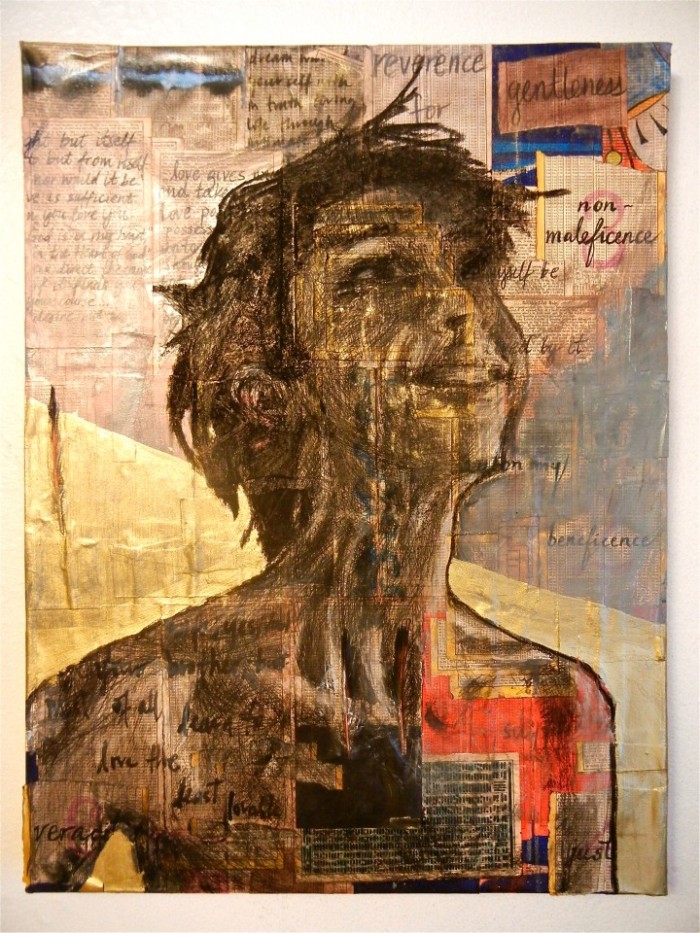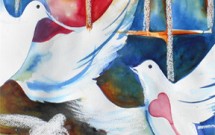
 Professional Ethics in Art Therapy
Professional Ethics in Art Therapy
Final Paper
Camille Grec
Autumn 2012
“But I say to you that when you work you fulfil a part of of earth’s furthest dream, assigned to you when that dream was born. …And in keeping yourself with labour you are in truth loving life, and to love life through labour is to be intimate with life’s innermost secret. …Work is love made visible.” -Kahlil Gibran
Einstein once said “Things should be made as simple as possible, but not any simpler.” During this quarter I have patiently, watchfully allowed my self to simmer in a fragrant soup of ethical concerns and practices, resulting in the distillation of my ethical experiences into an ancient question: How do I, as an Art Therapist, a Woman, a Human, most gracefully dance in the balance of the worldly and the spiritual? How do I keep one foot grounded in each reality, one eye open to each realm? How do I allow for the unfolding of my integrative spiritual growth and Medicine Woman-hood while maintaining an ethical and purposeful therapeutic practice? In other words, how may I experience my deeply spiritual form of life while allowing my client their own spiritual (or non-spiritual) experience?
I pull from my Shaman’s basket two medicine packets; the first speaks to my Therapist-Self, the part of me through which I express my purpose, and calls in the Tenets of Practice: Autonomy, Beneficence, Non-Maleficence, Justice, Fidelity, and Veracity. The second packet calls in my Highest Self, the part of me that is Source, and resonates the four virtues: Reverence for all of Life, Sincerity, Gentleness, and Supportiveness, which manifests as Service (Dyer, 2008). Are these so different? Am I not feeling the deepest of desires to fulfill these tenets and virtues, all of which may spring from a holy trinity of gratitude (surrender), peace (acceptance) and love (transformation)? I can sense I am getting rather lofty and so will focus my therapeutic and personal intention, which is as follows: To witness the energy of the expansively infinite express itself in the heartbreakingly mortal; to allow myself to soar into the greatest of heights while playing in the mud, and to be able to hold supportive, contained therapeutic space for another as they crawl from the deepest caves of their souls to the highest cliffs of their spirits, only to gently waft down to the valleys of their hearts, all the while supporting my own open heart to the lessons my clients bring into my life.
It seems as though an underlying theme I am working with is practicing holding the tensions of dual or multiple experiences while maintaining my core balance. A part of me is learning this in a very concrete, healing way through my personal work my with therapist; as we slowly address past issues of neglect and trauma, I am slowly rewiring disconnected parts of my brain, shifting from black and white trauma thinking into embracing the presence of safety, identity, and ever-shifting stability. In my heart I am learning this lesson in a different way as I surrender to a deeply felt sense of spiritual consciousness and unity while being in this physical realm of perceived Self and Other. These worlds overlap easily with other, as the earth’s sands greet the ocean’s rising tides, and I find that, like the dancing birds scrounging bits of dinner in the receding surf, I rest most gently somewhere in the middle, allowing for my healing presence in this world to be nurtured by the cosmic heartbeat.
Balancing dual experiences seems to be a lifelong motif, and I am finding that ‘balance’ is not a strict, rigid, unyielding stance equally supporting two different realities or choices, but rather a shimmering, whirling, dervish rhythm that one could find in a circus: On one hand, the magical act of ‘balance’ is a well-practiced routine guided by the laws of the physical world and supported by well-toned muscle and sinew and skill, while on the other hand it is an extraordinary surrender to grace through which the playful divine may be expressed. To ground this expansive discourse in a therapeutic context, one area in which I have ethical concern for myself is around the experience of Dual Processes, in which a client will bring into the therapy room experiences synchronistic (and/or triggering) to my own life process. How may I allow for experiencing the richness and depth of duel process rather than disconnecting from my own experience or becoming tangled in unconscious countertransference? One source of strength for me is the knowledge that going through the process of clarifying my own spiritual values allows me the freedom to incorporate this dimension of strength into my practice; self-awareness releases the fear of violating ethical principles. (Openshaw & Harr, 2005). For even if I do cross ethical boundaries, I pray I will be aware of the crossing and thus the door opens between client and therapist to the great healing experiences of making repairs and learning from missteps.
Keeping attentive awareness on the spiritual contracts between my future clients and myself will hopefully allow for the expanded space necessary for maintaining my therapeutic role and boundaries while tracking my own becoming. Furthermore, on those occasions when my own projections enter into the therapeutic relationships, it is important for me to remember that it can be a helpful part of the healing process if I am able to monitor my feelings during therapy sessions and use my responses as a source for understanding clients and helping clients to understand themselves (Corey, Corey & Callanan, 2011). This approach to countertransference encourages a re-centering of both therapist and client which in itself can be profoundly healing for both.
This brings me to one of the most valuable ethical tools I have taken from this class: to know my own positions and beliefs, and to learn how to recognize when something does not sit right within. This acknowledgement opens the path to locating where the discomfort lies and exploring it as a way in which to work through an ethical dilemma. Additionally, I have become sensitive to the importance of supervision and the support of colleagues, as well as to the gifts to be found in verbally, artistically, and ceremonially working through ethical issues. Bruce Moon (2006) speaks of these elements, along with professional expansion, as a “commitment to well-being.” He describes three commitments that support and encourage health within the therapist: the first is for a therapist to pay attention to quality in their personal lives. The second promotes active art making, focusing on the powerful medicine of artistically working through and discharging the intense emotions that occur in the field of therapy and counseling services. The final commitment to well-being motivates the therapist to stay connected and attuned to the professional field, keeping up with new research and techniques and expanding one’s own therapeutic abilities.
Bruce Moon’s perspective offers a centering practice from which I may approach problems or issues that crop up in either my work or my personal life, and this practice engages both my mind and my heart to find a course of action that is not only ethically and therapeutically sound but also stimulates my spiritually unfolding. Having spent much of this past year focusing on emotional healing and my spiritual development in joyfully surrendering to my purpose on this planet, I feel a strengthening in my foundation of trust in the greater dance of all. I am clearly aware, though, as I prepare for actually working with clients, I am beginning to spend more energy gathering experiences in solid reality as well as engaging in the metaphysical world, processing and healing ancient wounds. As with all cycles, there will be times when I land deep in shut-eyed, muddy struggle and shadowed conflict; in those times I will call upon the perspectives of my colleagues, my professional commitments, my kin, and my spiritual guides and ceremonial practices for support and counsel towards clear hearted, ethically grounded decision making. And so we come full circle in yet another level of this grand spiral of my intention and desire; To strive towards a simple, clear healing approach while being held by and reveling in the impossibly intricate connections of this tremendous reality we create.
“Love gives naught but itself and takes naught but from itself. Love possesses not nor would it be possessed; for love is sufficient unto love. When you love you should not say, “God is in my heart,” but rather, “I am in the heart of God.” And think not you can direct the course of love, for love, if it finds you worthy, directs your course. …Love has no other desire but to fulfill itself.” – K. Gibran
 Southwestern College Santa Fe, NM
Southwestern College Santa Fe, NM





